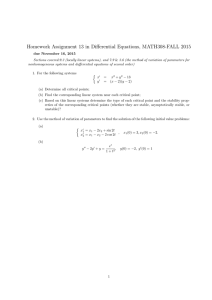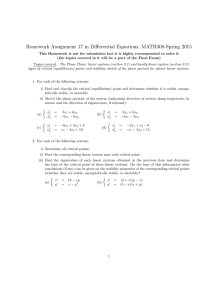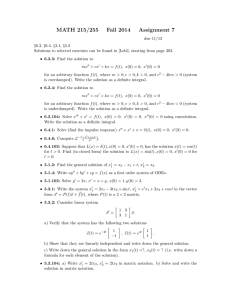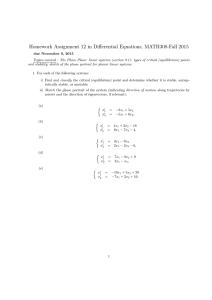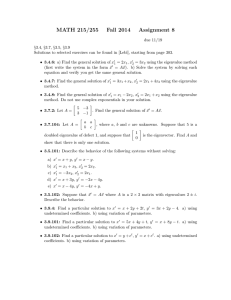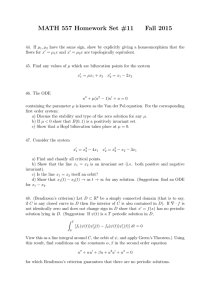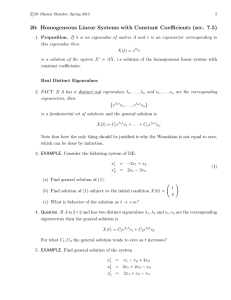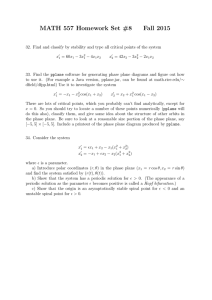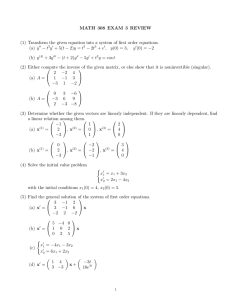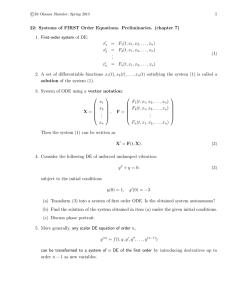ENERGY CONSERVATION AND BLOWUP OF SOLUTIONS FOR FOCUSING GROSS-PITAEVSKII HIERARCHIES
advertisement
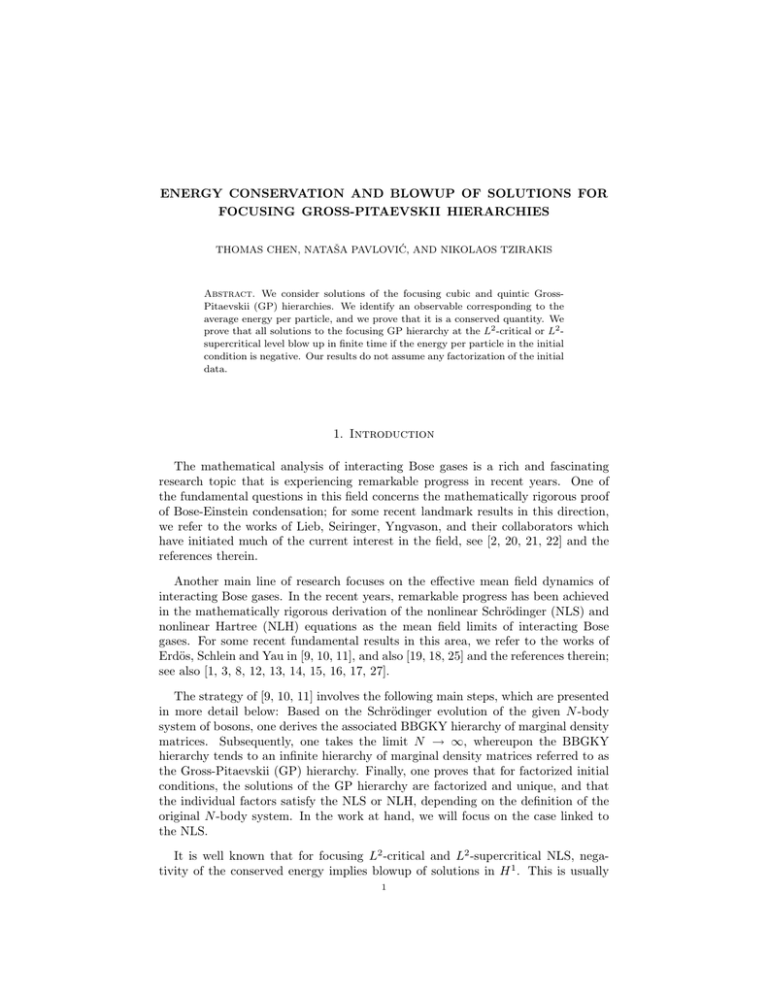
ENERGY CONSERVATION AND BLOWUP OF SOLUTIONS FOR
FOCUSING GROSS-PITAEVSKII HIERARCHIES
THOMAS CHEN, NATAŠA PAVLOVIĆ, AND NIKOLAOS TZIRAKIS
Abstract. We consider solutions of the focusing cubic and quintic GrossPitaevskii (GP) hierarchies. We identify an observable corresponding to the
average energy per particle, and we prove that it is a conserved quantity. We
prove that all solutions to the focusing GP hierarchy at the L2 -critical or L2 supercritical level blow up in finite time if the energy per particle in the initial
condition is negative. Our results do not assume any factorization of the initial
data.
1. Introduction
The mathematical analysis of interacting Bose gases is a rich and fascinating
research topic that is experiencing remarkable progress in recent years. One of
the fundamental questions in this field concerns the mathematically rigorous proof
of Bose-Einstein condensation; for some recent landmark results in this direction,
we refer to the works of Lieb, Seiringer, Yngvason, and their collaborators which
have initiated much of the current interest in the field, see [2, 20, 21, 22] and the
references therein.
Another main line of research focuses on the effective mean field dynamics of
interacting Bose gases. In the recent years, remarkable progress has been achieved
in the mathematically rigorous derivation of the nonlinear Schrödinger (NLS) and
nonlinear Hartree (NLH) equations as the mean field limits of interacting Bose
gases. For some recent fundamental results in this area, we refer to the works of
Erdös, Schlein and Yau in [9, 10, 11], and also [19, 18, 25] and the references therein;
see also [1, 3, 8, 12, 13, 14, 15, 16, 17, 27].
The strategy of [9, 10, 11] involves the following main steps, which are presented
in more detail below: Based on the Schrödinger evolution of the given N -body
system of bosons, one derives the associated BBGKY hierarchy of marginal density
matrices. Subsequently, one takes the limit N → ∞, whereupon the BBGKY
hierarchy tends to an infinite hierarchy of marginal density matrices referred to as
the Gross-Pitaevskii (GP) hierarchy. Finally, one proves that for factorized initial
conditions, the solutions of the GP hierarchy are factorized and unique, and that
the individual factors satisfy the NLS or NLH, depending on the definition of the
original N -body system. In the work at hand, we will focus on the case linked to
the NLS.
It is well known that for focusing L2 -critical and L2 -supercritical NLS, negativity of the conserved energy implies blowup of solutions in H 1 . This is usually
1
2
T. CHEN, N. PAVLOVIĆ, AND N. TZIRAKIS
proven by use of energy conservation combined with a virial identity, a method
often referred to as Glassey’s argument. In this paper, we are especially interested
in the phenomenon of blowup of solutions for the GP hierarchy without assuming
factorization of the initial conditions. More precisely, here we obtain an analogue
of Glassey’s argument for the GP hierarchy, and thereby, we establish blowup of
solutions to the GP hiearchy under the condition that the initial energy is negative.
First, for the convenience of the reader, we outline below the main steps along
which the defocusing cubic NLS is derived as the mean field limit for a gas of bosons
with repelling pair interactions, following [9, 10, 11]. For repelling three body interactions leading to the defocusing quintic NLS, we refer to [6]. We remark that
it is currently not known how to obtain analogous results for the case of attractive
interactions.
(i) From N -body Schrödinger to BBGKY. Let ψN ∈ L2 (RdN ) denote the wave
function describing N bosons in Rd . To account for the Bose-Einstein statistics,
ψN is invariant with respect to permutations π ∈ SN , which act by interchanging
the particle variables,
ψN (xπ(1) , xπ(2) , ..., xπ(N ) ) = ψN (x1 , x2 , ..., xN ) .
(1.1)
We denote L2s (RdN ) := {ψN ∈ L2 (RdN )| ψN satisfies (1.1)}. The dynamics of the
system is determined by the Schrödinger equation
i∂t ψN = HN ψN .
(1.2)
The Hamiltonian HN is assumed to be a self-adjoint operator acting on the Hilbert
space L2s (RdN ), of the form
HN =
N
X
1
(−∆xj ) +
N
j=1
X
VN (xi − xj ),
(1.3)
1≤i<j≤N
where VN (x) = N dβ V (N β x) with V ∈ W r,s (Rd ) spherically symmetric, for some
suitable r, s, and for β ∈ (0, 1) sufficiently small.
The limit N → ∞ is obtained in the following manner. One introduces the
density matrix
γN (t, xN , x0N ) = ψN (t, xN )ψN (t, x0N )
where xN = (x1 , x2 , ..., xN ) and x0N = (x01 , x02 , ..., x0N ). Moreover, one introduces the
(k)
associated sequence of k-particle marginal density matrices γN (t), for k = 1, . . . , N ,
as the partial trace of γN over the degrees of freedom of the last (N − k) particles,
(k)
γN = Trk+1,k+2,...,N |ψN ihψN | .
Here, Trk+1,k+2,...,N denotes the partial trace with respect to the particles indexed
(k)
by k + 1, k + 2, ..., N . Accordingly, γN is defined as the non-negative trace class
operator on L2s (Rdk ) with kernel given by
Z
(k)
γN (xk , x0k ) =
dxN −k γN (xk , xN −k ; x0k , xN −k )
Z
=
dxN −k ψN (xk , xN −k )ψN (x0k , xN −k ) .
(1.4)
BLOWUP SOLUTIONS FOR THE GP HIERARCHY
(k)
3
(k+1)
It is clear from the definitions given above that γN = Trk+1 γN
(k)
TrγN = kψN k2L2 (RdN ) = 1 for all N , and all k = 1, 2, ..., N .
, and that
s
The time evolution of the density matrix γN is determined by the Heisenberg
equation
i∂t γN (t) = [HN , γN (t)] ,
(1.5)
which is equivalent to
i∂t γN (t, xN , x0N )
= −(∆xN − ∆x0N )γN (t, xN , x0N )
(1.6)
X
1
[VN (xi − xj ) − VN (x0i − x0j )]γN (t, xN , x0N ) ,
+
N
1≤i<j≤N
expressed in terms of the associated integral kernel. Accordingly, the k-particle
marginals satisfy the BBGKY hierarchy
i∂t γ (k) (t, xk ; x0k ) = −(∆xk − ∆x0k )γ (k) (t, xk , x0k )
1 X
+
[VN (xi − xj ) − VN (x0i − x0j )]γ (k) (t, xk ; x0k )
N
(1.7)
1≤i<j≤k
k Z
N −k X
+
dxk+1 [VN (xi − xk+1 ) − VN (x0i − xk+1 )]
N i=1
(1.8)
γ (k+1) (t, xk , xk+1 ; xk , x0k+1 )
where ∆xk :=
Pk
j=1
k2
N
∆xj , and similarly for ∆x0k . We note that the number of terms
→ 0, and the number of terms in (1.8) is k(NN−k) → k as N → ∞.
in (1.7) is ≈
Accordingly, for fixed k, (1.7) disappears in the limit N → ∞ described below,
while (1.8) survives.
(ii) From BBGKY to GP. It is proven in [9, 10, 11] that, for a suitable topology on
the space of marginal density matrices, and as N → ∞, one can extract convergent
(k)
subsequences γN → γ (k) for k ∈ N, which satisfy the infinite limiting hierarchy
i∂t γ (k) (t, xk ; x0k )
= − (∆xk − ∆x0k )γ (k) (t, xk ; x0k )
+ b0
k
X
(1.9)
Bj,k+1 γ k+1 (t, xk ; x0k ) ,
j=1
which is referred to as the Gross-Pitaevskii (GP) hierarchy. Here,
(Bj,k+1 γ k+1 )(t, xk ; x0k )
Z
:=
dxk+1 dx0k+1 [δ(xj − xk+1 )δ(xj − x0k+1 ) − δ(x0j − xk+1 )δ(x0j − x0k+1 )]
γ (k+1) (t, xk , xk+1 ; x0k , x0k+1 ) ,
R
and b0 = V (x)dx. The interaction term here is obtained from the limit of (1.8)
as N → ∞, using that VN (x) → b0 δ(x) weakly. We will set b0 = 1 in the sequel.
(iii) NLS and factorized solutions of GP. The link between the original bosonic N body system and solutions of the NLS is established as follows. Given factorized
4
T. CHEN, N. PAVLOVIĆ, AND N. TZIRAKIS
k−particle marginals
(k)
γ0 (xk ; x0k ) =
k
Y
φ0 (xj )φ0 (x0j )
j=1
1
d
at initial time t = 0, with φ0 ∈ H (R ), one can easily verify that the solution of
the GP hierarchy remains factorized for all t ∈ I ⊆ R,
(k)
γ0 (t, xk ; x0k ) =
k
Y
φ(t, xj )φ(t, x0j ) ,
j=1
if φ(t) ∈ H 1 (Rd ) solves the defocusing cubic NLS,
i∂t φ = −∆x φ + |φ|2 φ ,
(1.10)
for t ∈ I, and φ(0) = φ0 ∈ H 1 (Rd ).
Solutions of the GP hierarchy are studied in spaces of k-particle marginals with
norms kγ (k) k]H 1 := Tr(S (k) γ (k) ) < ∞ or kγ (k) kHk1 := (Tr(S (k) γ (k) )2 )1/2 < ∞ where
Qk k
S (k) := j=1 h∇xj ih∇x0j i, and Hkα ≡ H α (Rdk × Rdk ) for brevity. While the existence of factorized solutions can be easily obtained, as outlined above, the question
remains whether solutions of the GP hierarchy are also unique.
The proof of uniqueness of solutions of the GP hierarchy is the most difficult
part in the program outlined above, and it was originally accomplished by Erdös,
Schlein and Yau in [9, 10, 11] by use of sophisticated Feynman graph expansion
methods. In [19] Klainerman and Machedon proposed an alternative method for
proving uniqueness based on use of space-time bounds on the density matrices and
introduction of an elegant “board game” argument whose purpose is to organize
the relevant combinatorics related to expressing solutions of the GP hierarchy using
iterated Duhamel formulas. For the approach developed in [19], the authors assume
that the a priori space-time bound
kBj;k+1 γ (k+1) kL1 Ḣ 1 < C k ,
t
(1.11)
k
holds, with C independent of k. The authors of [18] proved that the latter is indeed
satisfied for the cubic case in d = 2, based on energy conservation.
Non-factorized solutions of focusing and defocusing GP hierarchies. As mentioned
above, it is currently only known how to obtain a GP hierarchy from the N → ∞
limit of a BBGKY hierarchy with repulsive interactions, but not for attractive
interactions.
However, in the work at hand, we will, similarly as in [7], start directly from the
level of the GP hierarchy, and allow ourselves to also discuss attractive interactions.
Accordingly, we will refer to the corresponding GP hierarchies as cubic, quintic,
focusing, or defocusing GP hierarchies, depending on the type of the NLS governing
the solutions obtained from factorized initial conditions.
Recently, in [7], two of us analyzed the Cauchy problem for the cubic and quintic
GP hierarchy in Rd , d ≥ 1 with focusing and defocusing interactions, and proved
BLOWUP SOLUTIONS FOR THE GP HIERARCHY
5
the existence and uniqueness of solutions to the GP hierarchy that satisfy the spacetime bound (1.11) which was assumed in [19]. As a key ingredient of the arguments
in [7] a suitable topology is introduced on the space of sequences of marginal density
matrices,
G = { Γ = ( γ (k) (x1 , . . . , xk ; x01 , . . . , x0k ) )k∈N | Trγ (k) < ∞ } .
It is determined by the generalized Sobolev norms
X
k Γ kHαξ :=
ξ k k γ (k) kHkα ,
(1.12)
(1.13)
k∈N
parametrized by ξ > 0, and the spaces Hξα = { Γ ∈ G | k Γ kHαξ < ∞ } were introduced. The parameter ξ > 0 is determined by the initial condition, and it sets the
energy scale of a given Cauchy problem; if Γ ∈ Hξα , then ξ −1 is an upper bound
on the typical H α -energy per particle. The parameter α determines the regularity
of the solution. In [7], the local in time existence and uniqueness of solutions is
established for cubic, quintic, focusing and defocusing GP hierarchies in Hξα for α in
b L1 Hα < CkΓ0 kHα
a range depending on d, which satisfy a spacetime bound kBΓk
ξ0
t∈I
ξ
p
b := ( Bk+ p γ (k+ 2 ) )k∈N ). The precise statement and
for some 0 < ξ ≤ ξ0 (here BΓ
2
the associated consequences that we will use in this paper are presented in the next
section. This result implies, in particular, (1.11).
In this paper we study solutions of focusing GP hierarchies without any factorization condition, and especially establish the following results characterizing the
blowup of solutions:
(1) For defocusing cubic GP hierarchies in d = 1, 2, 3, and defocusing quintic GP hierarchies in d = 1, 2, which are obtained as limits of BBGKY
hierarchies as outlined above, it is possible to derive a priori bounds on
1 based on energy conservation in the N -particle Schrödinger
kγ (k) (t)kL∞
t Hk
system, see [9, 10, 11], and also [6, 18]. However, on the level of the GP
hierarchy, no conserved energy functional has so far been known. We identify an observable corresponding to the average energy per particle, and we
prove that it is conserved.
(2) Furthermore, we prove the virial identity on the level of the GP hierarchy that enables us to obtain an analogue of Glassey’s argument from the
analysis of focusing NLS equations. As a consequence, we prove that all
solutions to the focusing GP hierarchy at the L2 -critical or L2 -supercritical
level blow up in finite time if the energy per particle in the initial condition
is negative.
Organization of the paper. In Section 2 we present the notation and the preliminaries. The main results of the paper are stated in Section 3. In Section 4 we
identify the average energy per particle and prove that it is a conserved quantity.
In Section 5, we derive a virial identity that enables us to prove an analogue of
Glassey’s blow-up argument familiar from the analysis of NLS. The analogue of
Glassey’s blowup argument is presented in Section 6.
6
T. CHEN, N. PAVLOVIĆ, AND N. TZIRAKIS
2. Definition of the model and preliminaries
We introduce the space
G :=
∞
M
L2 (Rdk × Rdk )
(2.1)
k=1
of sequences of density matrices
Γ := ( γ (k) )k∈N
(k)
(k)
(2.2)
(k)
(xk , x0k )
is symmetric in all
where γ
≥ 0, Trγ
= 1, and where every γ
components of xk , and in all components of x0k , respectively, i.e.
γ (k) (xπ(1) , ..., xπ(k) ; x0π0 (1) , ..., x0π0 (k) ) = γ (k) (x1 , ..., xk ; x01 , ..., x0k )
(2.3)
holds for all π, π 0 ∈ Sk .
Moreover, the k-particle marginals are hermitean,
γ (k) (xk ; x0k ) = γ (k) (x0k ; xk ).
(2.4)
p
We call Γ = (γ (k) )k∈N admissible if γ (k) = Trk+1,...,k+ p2 γ (k+ 2 ) , that is,
γ (k) (xk ; x0k )
(2.5)
Z
p
=
dxk+1 · · · dxk+ p2 γ (k+ 2 ) (xk , xk+1 , . . . , xk+ p2 ; x0k , xk+1 , . . . , xk+ p2 )
for all k ∈ N.
We will use the following convention for the Fourier transform,
Z
0 0
γ(xk ; x0k ) = duk du0k eiuk xk −iuk xk γ
b(uk ; u0k ).
Let 0 < ξ < 1. We define
Hξα :=
n
o
Γ ∈ G kΓkHαξ < ∞
(2.6)
where
kΓkHαξ =
∞
X
ξ k k γ (k) kH α (Rdk ×Rdk ) ,
(2.7)
k=1
with
k γ (k) kH α (Rdk ×Rdk ) = k S (k,α) γ (k) kL2 (Rdk ×Rdk ) ,
(2.8)
Q
k
and S (k,α) := j=1 h∇xj iα h∇x0j iα . Clearly, Hξα is a Banach space. Similar spaces
are used in the isospectral renormalization group analysis of spectral problems in
quantum field theory, [4].
Next, we define the cubic, quintic, focusing, and defocusing GP hierarchies. Let
p ∈ {2, 4}. The p-GP (Gross-Pitaevskii) hierarchy is given by
i∂t γ (k) =
k
X
j=1
p
[−∆xj , γ (k) ] + µBk+ p2 γ (k+ 2 )
(2.9)
BLOWUP SOLUTIONS FOR THE GP HIERARCHY
7
in d dimensions, for k ∈ N. Here,
p
Bk+ p2 γ (k+ 2 ) (t, x1 , . . . , xk ; x01 , . . . , x0k )
:=
k X
(2.10)
p
Bj;k+1,...,k+ p2 γ (k+ 2 ) (t, x1 , . . . , xk ; x01 , . . . , x0k )
j=1
:=
k
X
(k+ p
1
2)
pγ
(t, x1 , . . . , xk ; x01 , . . . , x0k )
Bj;k+1,...,k+
2
j=1
2
(k+ p
2)
pγ
(t, x1 , . . . , xk ; x01 , . . . , x0k ) ,
− Bj;k+1,...,k+
2
where
1
(k+ p
2)
pγ
Bj;k+1,...,k+
(t, x1 , . . . , xk ; x01 , . . . , x0k )
2
Z
= dxk+1 · · · dxk+ p2 dx0k+1 · · · dx0k+ p
2
k+ p
2
Y
p
δ(xj − x` )δ(xj − x0` )γ (k+ 2 ) (t, x1 , . . . , xk+ p2 ; x01 , . . . , x0k+ p ),
2
`=k+1
and
(k+ p
2
2)
pγ
Bj;k+1,...,k+
(t, x1 , . . . , xk ; x01 , . . . , x0k )
2
Z
= dxk+1 · · · dxk+ p2 dx0k+1 · · · dx0k+ p
2
k+ p
2
Y
p
δ(x0j − x` )δ(x0j − x0` )γ (k+ 2 ) (t, x1 , . . . , xk+ p2 ; x01 , . . . , x0k+ p ).
2
`=k+1
p
The operator Bk+ p2 γ (k+ 2 ) accounts for p2 + 1-body interactions between the Bose
particles. We note that for factorized solutions, the corresponding 1-particle wave
function satisfies the p-NLS i∂t φ = −∆φ + µ|φ|p φ.
We refer to (2.9) as the cubic GP hierarchy if p = 2, and as the quintic GP
hierarchy if p = 4. Also we denote the L2 -critical exponent by pL2 = d4 and refer to
(2.9) as a L2 -critical GP hierarchy if p = pL2 and as a L2 -supercritical GP hierarchy
if p > pL2 . Moreover, for µ = 1 or µ = −1 we refer to the GP hierarchies as being
defocusing or focusing, respectively.
To obtain the blow-up property, we need a result providing a blow-up alternative.
This is a usually obtained as a byproduct of the local theory. In the context of the
local theory developed in [7], we recall the following two theorems: Theorem 2.1
which establishes the local well-posedness of the GP equation and Theorem 2.5 that
gives lower bounds on the blow-up rate. In order to state these two theorems, we
recall that in [7] the GP hieararchy was rewritten in the following way:
b ± Γ = µBΓ
b ,
i∂t Γ + ∆
(2.11)
where
b ± Γ := ( ∆(k) γ (k) )k∈N
∆
±
with
(k)
∆± = ∆xk − ∆x0k ,
8
T. CHEN, N. PAVLOVIĆ, AND N. TZIRAKIS
and
b := ( Bk+ p γ (k+ p2 ) )k∈N .
BΓ
2
(2.12)
Also the following set A(d, p) was introduced in [7], for p = 2, 4 and d ≥ 1,
( 21 , ∞)
if d = 1
1
d
, ∞) if d ≥ 2 and (d, p) 6= (3, 2)
( −
(2.13)
A(d, p) =
2 2(p−1)
1, ∞)
if (d, p) = (3, 2)
which we will use to account for the regularity of solutions.
Now we recall the local well-posedness theorem proved in [7].
Theorem 2.1. Let ξ1 > 0. Assume that α ∈ A(d, p) where d ≥ 1 and p ∈ {2, 4},
and 0 < η < 1 sufficiently small. Then, the following hold.
(i) For every Γ0 ∈ Hξα1 , there exist constants T > 0 and 0 < ξ2 ≤ ξ1 such that
the following holds. There exists a unique solution Γ(t) in the space
α
b
{Γ ∈ L∞
< ∞} .
t∈[0,T ] Hξ2 | kBΓkL1t∈[0,T ] Hα
ξ
2
In particular this solution satisfies the Strichartz-type bound
b L1 Hα ≤ C(T, d, p, ξ1 , ξ2 ) kΓ0 kHα .
kBΓk
t∈I
ξ2
ξ1
(2.14)
α
(ii) The uniqueness of solutions in the space L∞
t∈[0,T ] Hξ2 is characterized as
α
follows. Given Γ0 ∈ Hξ1 , assume that there are constants T > 0 and
0 < ξ2 ≤ ξ1 such that there exists a solution Γ(t) of the p-GP hierarchy
α
(2.9) in the space L∞
t∈[0,T ] Hξ2 .
α
b
Then, this solution is unique in L∞
<∞
t∈[0,T ] Hξ2 if and only if k BΓ kL1t∈I Hα
ξ
holds for some ξ > 0.
Definition 2.2. We say that a solution Γ(t) of the GP hierarchy blows up in finite
time with respect to H α if there exists T ∗ < ∞ such that the following holds: For
∗
∗
every ξ > 0 there exists Tξ,Γ
< T ∗ such that kΓ(t)kHαξ → ∞ as t % Tξ,Γ
. Moreover,
∗
∗
Tξ,Γ % T as ξ → 0.
For the study of blowup solutions, it is convenient to introduce the following
quantity.
Definition 2.3. We refer to
h
i−1
AvH α (Γ) := sup ξ > 0 k Γ kHαξ < ∞
,
(2.15)
i−1
sup ξ > 0 k Γ kLrξ < ∞
,
(2.16)
AvLr (Γ) :=
h
respectively, as the typical (or average) H α -energy and the typical Lr -norm per
particle.
We then have the following characterization of blowup.
BLOWUP SOLUTIONS FOR THE GP HIERARCHY
9
Lemma 2.4. Blowup in finite time of Γ(t) with respect to H α as t % T ∗ , as
characterized in Definition 2.2, is equivalent to the statement that AvH α (Γ(t)) → ∞
as t % T ∗ (and similarly for Lr ).
Proof. Clearly, AvH α (Γ) is the reciprocal of the convergence radius of kΓkHαξ as a
power series in ξ. Accordingly, kΓkHαξ < ∞ for ξ < AvH α (Γ)−1 , and kΓkHαξ = ∞
for ξ ≥ AvH α (Γ)−1 .
Blowup in finite time of Γ(t) in H α as t % T ∗ , as characterized in Definition
2.2, is equivalent to the statement that the convergence radius of kΓ(t)kHαξ , as a
power series in ξ, tends to zero as t % T ∗ . Thus, in turn, blowup in finite time of
Γ(t) with respect to H α is equivalent to the statement that AvH α (Γ(t)) → ∞ as
t % T ∗.
The following theorem from [7] gives lower bounds on the blow-up rate.
Theorem 2.5. Assume that Γ(t) is a solution of the (cubic p = 2 or p = 4 quintic)
p-GP hierarchy with initial condition Γ(t0 ) = Γ0 ∈ Hξα , for some ξ > 0, which
blows up in finite time. Then, the following lower bounds on the blowup rate hold:
(a) Assume that
4
d
≤p<
4
d−2α .
Then,
C
1
( AvH α (Γ(t)) ) 2 >
4
(2α−d+ p
)/4
|T ∗ − t|
.
(2.17)
Thus specifically, for the cubic GP hierarchy in d = 2, and for the quintic
GP hierarchy in d = 1,
1
( AvH 1 (Γ(t)) ) 2 ≥
C
1
|t − T ∗ | 2
,
(2.18)
with respect to the Sobolev spaces H α , Hξα .
(b)
1
( AvLr (Γ(t)) ) 2 ≥
C
|t − T ∗ |
1
d
p − 2r
, for
pd
< r.
2
(2.19)
Remark 2.6. We note that in the factorized case, the above lower bounds on the
blow-up rate coincide with the known lower bounds on the blow-up rate for solutions
to the NLS (see, for example, [5]).
We note that
Γ = ( | φ ih φ |⊗k )k∈N
⇒
AvH α (Γ) = kφk2H α and AvLr (Γ) = kφk2Lr (2.20)
in the factorized case.
The fact that Γ ∈ Hξα means that the typical energy per particle is bounded by
AvH α (Γ) < ξ −1 . Therefore, the parameter ξ determines the H α -energy scale in the
problem. While solutions with a bounded H α -energy remain in the same Hξα for
some sufficiently small ξ > 0, blowup solutions undergo transitions Hξα1 → Hξα2 →
Hξα3 → · · · where the sequence ξ1 > ξ2 > · · · converges to zero as t → T ∗ .
10
T. CHEN, N. PAVLOVIĆ, AND N. TZIRAKIS
We emphasize again that (AvN (Γ))−1 is the convergence radius of kΓkNξ as a
power series in ξ, for the norms N = H α , Lr and Nξ = Hξα , Lrξ , respectively.
3. Statement of the main results
The following two Theorems are the main results of this paper. First we prove
energy conservation per particle for solutions Γ(t) of the p-GP hierarchy. More
precisely,
Theorem 3.1. Let 0 < ξ < 1. Assume that Γ(t) ∈ Hξα , with α ≥ 1, is a solution of
the focusing (µ = −1) or defocusing (µ = 1) p-GP hierarchy with initial condition
Γ0 ∈ Hξα . Then, the following hold. Let
Ek ( Γ(t) )
:=
k
X
1
Tr(
(−∆xj )γ (k) (t) )
2
j=1
+
(3.1)
k
X
µ
1
(k+ p
2 ) (t) ).
p γ
Tr(
Bj;k+1,...,k+
2
p+2
j=1
Then, the quantity
Enξ ( Γ(t) ) :=
X
ξ k Ek ( Γ(t) )
(3.2)
kξ k E1 ( Γ(t) ) ,
(3.3)
k≥1
is conserved, and in particular,
Enξ ( Γ(t) ) =
X
k≥1
where
P
k≥1
kξ k < ∞ for any 0 < ξ < 1.
that Tr(A) means integration of the kernel A(x, x0 ) against the measure
R We recall
0
dxdx δ(x − x0 ). We note that for factorized states Γ(t) = (|φ(t)ihφ(t)|⊗k )k∈N , one
finds
1
µ
E1 ( Γ(t) ) = k∇φ(t)k2L2 +
kφ(t)kp+2
(3.4)
Lp+2 ,
2
p+2
which is the usual expression for the conserved energy for solutions of the NLS
i∂t φ + ∆φ + µ|φ|p φ = 0.
Theorem 3.2. Let p ≥ pL2 . Assume that Γ(t) = ( γ (k) (t) )k∈N solves the focusing
(i.e., µ = −1) p-GP hierarchy with initial condition Γ(0) ∈ Hξ1 for some 0 < ξ < 1,
with Tr( x2 γ (1) (0) ) < ∞. If E1 ( Γ(0) ) < 0, then there exists T ∗ < ∞ such that
AvH 1 (Γ(t)) → ∞ as t % T ∗ .
Remark 3.3. We note that Theorem 3.2 is proved under the assumption that
Tr( x2 γ (1) (0) ) < ∞, which is analogous to the finite variance assumption in the
case of Glassey’s blow-up argument for the NLS (see, e.g. [5] Theorem 6.5.4).
As a motivation for the proofs presented below, we briefly recall the application
of Glassey’s argument in the case of an L2 -critical or supercritical focusing NLS.
We consider a solution of i∂t φ = −∆φ − |φ|p φ with φ(0) = φ0 ∈ H 1 (Rd ) and
p ≥ pL2 = d4 , such that the conserved energy satisfies E[φ(t)] := 12 k∇φ(t)k2L2 −
BLOWUP SOLUTIONS FOR THE GP HIERARCHY
11
p+2
1
p+2 kφ(t)kLp+2
= E[φ0 ] < 0. Moreover, we assume that k |x|φ0 kL2 < ∞. Then, one
considers the quantity V (t) := hφ(t), x2 φ(t)i, which is shown to satisfy the virial
identity
∂t2 V (t) = 16E[φ0 ] − 4d
p − pL2
kφ(t)kp+2
Lp+2 .
p+2
(3.5)
Hence, if E[φ0 ] < 0, and p ≥ pL2 , there exists a finite time T ∗ such that the positive
quantity V (t) & 0 as t % T ∗ . Accordingly, this implies that kφ(t)kH 1 (Rd ) % ∞ as
t % T ∗ (for more details, see Section 6). This phenomenon is referred to as negative
energy blowup in finite time for the NLS. In the sequel, we will prove analogues of
these arguments for the GP hierarchy.
4. Conservation of energy
In this section, we prove Theorem 3.1. We first demonstrate the proof for the
cubic case, p = 2. To begin with, we note that
Ek ( Γ(t) ) = kE1 ( Γ(t) )
(4.1)
for Γ(t) = (γ (k) (t))k∈N a solution of the cubic GP hierarchy, where by definition,
all γ (k) ’s are admissible. To prove this, we note that (3.1) can be written as
Ek ( Γ(t) )
=
k h
X
1
j=1
2
Tr( (−∆xj )γ (k) (t) )
+
i
µ
1
Tr( Bj,k+1
γ (k+1) (t) ) ,
4
(4.2)
where each of the terms in the sum equals the one obtained for j = 1, by symmetry
of γ (k) and γ (k+1) with respect to their variables. We present the detailed calculation for the interaction term, and note that the calculation for the kinetic energy
term is similar. Consider 1 ≤ i < j ≤ k. We have that
1
(Bj,k+1
γ (k+1) )(x1 , x2 , ..., xk ; x01 , x02 , ..., x0k )
=
(4.3)
γ (k+1) (x1 , x2 , ..., xi , ..., xj , ..., xk , xj ; x01 , x02 , ..., x0i , ..., x0j , ..., x0k , xj ) ,
and
1
(Bi,k+1
γ (k+1) )(x1 , x2 , ..., xk ; x01 , x02 , ..., x0k )
=
γ
(k+1)
(4.4)
(x1 , ..., xi , ..., xj , ..., xk , xi ; x01 , ..., x0i , ..., x0j , ..., x0k , xi ) .
Thus
1
Tr(Bj,k+1
γ (k+1) )
(4.5)
Z
=
γ (k+1) (x1 , ..., xi , ..., xj , ..., xk , xj ; x1 , ...xi , ..., xj , ..., xk , xj )dx1 dx2 ...dxk .
By the symmetry of γ (k+1) (xk+1 ; x0k+1 ) with respect to the components of xk+1
and x0k+1 , respectively,
1
1
Tr(Bj,k+1
γ (k+1) ) = Tr(Bi,k+1
γ (k+1) )
12
T. CHEN, N. PAVLOVIĆ, AND N. TZIRAKIS
for all i, j ∈ {1, . . . , k}. Thus,
Ek ( Γ(t) )
= k
h1
2
Tr( (−∆x1 )γ (k) (t) )
+
i
µ
1
Tr( B1,k+1
γ (k+1) (t) )
4
(4.6)
follows.
We can go one step further and note that
1
(B1,k+1
γ (k+1) )(x1 , x2 , ..., xk ; x01 , x02 , ..., x0k )
=
γ (k+1) (x1 , x2 , ..., xk , x1 ; x01 , x02 , ..., x0k , x1 ).
(4.7)
Then
1
Tr(B1,k+1
γ (k+1) )
Z
=
Z
=
γ k+1 (x1 , x2 , ..., xk , x1 ; x1 , x2 , ..., xk , x1 )dx1 dx2 ...dxk
γ (k+1) (x1 , x1 , x2 , ..., xk ; x1 , x1 , x2 , ..., xk )dx1 dx2 ...dxk
where in the last equality we used symmetry of γ (k+1) . On the other hand,
1
(B1,2
γ (2) )(x1 ; x01 )
= γ (2) (x1 , x1 ; x01 , x1 )
(4.8)
Z
=
γ (k+1) (x1 , x1 , x2 , ..., xk ; x01 , x1 , x2 , ..., xk )dx2 ...dxk
by repeated use of the admissibility of γ (j) , for j = 2, . . . , k + 1. Thus,
Z
1
Tr(B1,2
γ (2) ) = γ (k+1) (x1 , x1 , x2 , ..., xk ; x1 , x1 , x2 , ..., xk )dx1 dx2 ...dxk
and
1
1
Tr(B1,k+1
γ (k+1) ) = Tr(B1,2
γ (2) )
follows. Therefore,
Ek ( Γ(t) )
= k
h1
Tr( (−∆x1 )γ (1) (t) ) +
2
= kE1 ( Γ(t) ) ,
i
µ
1
Tr( B1,2
γ (2) (t) )
4
(4.9)
as claimed.
The fact that (3.3) then follows is evident.
Next, we verify that E1 ( Γ(t) ) is a conserved quantity, which means that E1 ( Γ(t) ) =
E1 ( Γ(0) ) for all t ∈ R.
For the proof, the following auxiliary identities are very useful:
Z
dxdx0 δ(x − x0 )∇x · ∇x0 A(x; x0 )
Z
=
dxdx0 δ(x − x0 )∆x A(x; x0 )
Z
=
dxdx0 δ(x − x0 )∆x0 A(x; x0 ) .
(4.10)
(4.11)
BLOWUP SOLUTIONS FOR THE GP HIERARCHY
To prove (4.10), we note that
Z
dxdx0 δ(x − x0 )∇x · ∇x0 A(x; x0 )
Z
Z
0 0
b u0 )
= − dudu0 dxdx0 δ(x − x0 ) eiux−iu x u · u0 A(u;
Z
b u0 )
= − dudu0 δ(u − u0 ) u · u0 A(u;
Z
b u0 )
= − dudu0 δ(u − u0 ) u2 A(u;
Z
Z
0 0
b u0 )
= − dudu0 dxdx0 δ(x − x0 ) eiux−iu x u2 A(u;
Z
b x0 ) .
=
dxdx0 δ(x − x0 ) ∆x A(x;
13
(4.12)
The equality (4.11) can be proved in a similar way.
We now return to the proof of E1 ( Γ(t) ) = E1 ( Γ(0) ). For k = 1, we consider
γ (1) (x, x0 ) where
E1 ( Γ(t) )
1
(4.13)
= − Tr( ∇x · ∇x0 γ (1) )
2 Z
µ
dx1 dx2 dx01 dx02 δ(x1 = x2 = x01 = x02 ) γ (2) (x1 , x2 ; x01 , x02 )
+
4
in symmetrized form. Here, we have introduced the shorthand notation
δ(x1 = x2 = x01 = x02 ) := δ(x1 − x2 )δ(x1 − x02 )δ(x2 − x02 ) .
(4.14)
i∂t E1 ( Γ(t) ) = (I) + (II) + (III) + (IV )
(4.15)
Clearly,
where
(I) :=
1
Tr( ∇x · ∇x0 (∆x − ∆x0 )γ (1) ) .
2
µ
(II) := − Tr( ∇x · ∇x0 (B1,2 γ (2) ) )
2
(III)
:= −
µ
4
Z
dx1 dx2 dx01 dx02 δ(x1 = x2 = x01 = x02 )
(4.16)
(4.17)
(4.18)
(∆x1 + ∆x2 − ∆x01 − ∆x02 )γ (2) (x1 , x2 ; x01 , x02 )
(IV )
:=
µ
4
Z
dx1 dx2 dx01 dx02 δ(x1 = x2 = x01 = x02 )
(B3 γ (3) )(x1 , x2 ; x01 , x02 ) .
(4.19)
14
T. CHEN, N. PAVLOVIĆ, AND N. TZIRAKIS
The term (I). We claim that (I) = 0. We note that
Tr( ∇x · ∇x0 (∆x − ∆x0 )γ (1) )
Z
Z
0 0
0
dxdx0 δ(x − x0 ) u · u0 (u2 − (u0 )2 ) eiux−iu x γ
=
dudu
b(1) (u; u0 )
Z
=
dudu0 δ(u − u0 ) u · u0 (u2 − (u0 )2 ) γ
b(1) (u; u0 )
=
0.
(4.20)
This proves the claim.
The term (IV ). We claim that (IV ) also vanishes. Indeed,
Z
µ
(IV ) =
dx1 dx2 dx01 dx02 δ(x1 = x2 = x01 = x02 )
4
(B3 γ (3) )(x1 , x2 ; x01 , x02 )
=
X µ
4
j=1,2
Z
dx1 dx2 dx01 dx02 δ(x1 = x2 = x01 = x02 )
h
γ (3) (x1 , x2 , x1 ; x01 , x02 , x1 ) − γ (3) (x1 , x2 , x01 ; x01 , x02 , x01 )
i
+ γ (3) (x1 , x2 , x2 ; x01 , x02 , x2 ) − γ (3) (x1 , x2 , x02 ; x01 , x02 , x02 )
Z
h
i
µ
= 2
dx γ (3) (x, x, x; x, x, x) − γ (3) (x, x, x; x, x, x)
4
= 0.
(4.21)
This proves the claim.
The term (III). By symmetry of γ (2) (x1 , x2 ; x01 , x02 ) in (x1 , x2 ), and in (x01 , x02 ), we
find
Z
µ
dx1 dx2 dx01 dx02 δ(x1 = x2 = x01 = x02 )
(III) = −2
4
(∆x1 − ∆x01 )γ (2) (x1 , x2 ; x01 , x02 )
= −
µ
2
Z
dx1 dx01 δ(x1 − x01 )
(4.22)
h
i
(∆x1 γ (2) )(x1 , x01 ; x01 , x01 ) − (∆x01 γ (2) )(x1 , x1 ; x01 , x1 ) .
We will show that this term is canceled by the term (II).
The term (II). We have
(II)
=
=
µ
− Tr( ∇x · ∇x0 (B1,2 γ (2) ) )
(4.23)
2Z
µ
−
dxdx0 δ(x − x0 )∇x · ∇x0 (γ (2) (x1 , x1 ; x01 , x1 ) − γ (2) (x1 , x01 ; x01 , x01 ))
2
BLOWUP SOLUTIONS FOR THE GP HIERARCHY
15
Now we use (4.10), and we obtain
Z
µ
dx1 dx01 δ(x1 − x01 )
(4.24)
(II) = −
2
h
i
(∆x01 γ (2) )(x1 , x1 ; x01 , x1 ) − (∆x1 γ (2) )(x1 , x01 ; x01 , x01 )) .
Hence (4.22) and (4.24) imply (II) = −(III).
We conclude that ∂t E1 (Γ(t)) = 0. Therefore, E1 (Γ(t)) = E1 (Γ(0)) is a conserved
quantity. It represents the average energy per particle. For the quintic case p = 4
(or similarly in more general cases p ∈ 2N), the above arguments can be adapted
straightforwardly.
5. Virial identities
In this section, we prove the virial identities necessary for the application of a
generalized version of Glassey’s argument. According to our previous discussion, it
is sufficient to consider only γ (1) (x1 ; x01 ).
5.1. Density. In what follows, we drop the superscript “(k)” from γ (k) . It will be
clear from the number of variables what the value of k (in this part of the discussion,
k = 1 or k = 2) is in a given expression.
We write
γ(x; x0 ) =
Z
0
0
dvdv 0 eivx−iv x γ
b(v; v 0 )
(5.1)
and define
Z
ρ(x) := γ(x; x) =
0
dv dv 0 ei(v−v )x γ
b(v; v 0 ) .
(5.2)
Thus,
Z
∂t ρ(x)
0
dv dv 0 ei(v−v )x ∂t γ
b(v; v 0 )
Z
0
1
dv dv 0 ei(v−v )x (∆x\
− ∆x0 )γ(v, v 0 )
= −
i
Z
0
1
0
\
+
dvdv 0 ei(v−v )x B
1,2 γ(v; v ).
i
=
First we notice that
Z
0
1
−
dv dv 0 ei(v−v )x (∆x\
− ∆x0 )γ(v, v 0 )
i
Z
0
1
=
dv dv 0 ei(v−v )x (v 2 − (v 0 )2 ) γ
b(v; v 0 )
i
Z
0
1
=
dv dv 0 ei(v−v )x (v + v 0 )(v − v 0 ) γ
b(v; v 0 )
i
Z
0
= ∇x · dv dv 0 ei(v−v )x (v + v 0 ) γ
b(v; v 0 ) .
(5.3)
(5.4)
16
T. CHEN, N. PAVLOVIĆ, AND N. TZIRAKIS
On the other hand,
1
B1,2
γ(x; x0 )
Z
dy dy 0 δ(x − y) δ(x − y 0 )
Z
0 0
0 0
dudqdu0 dq 0 ei(ux+qy−u x −q y ) γ
b(u, q; u0 , q 0 )
Z
dudqdu0 dq 0 ei((u+q−q )x−u x ) γ
b(u, q; u0 , q 0 ) .
=
=
0
0
0
(5.5)
Therefore,
0
1
\
B
1,2 γ(v; v )
Z
=
0
0
1
dxdx0 e−ivx+iv x B1,2
γ(x; x0 )
Z
dudqdu0 dq 0 δ(u + q − q 0 − v) δ(v 0 − u0 ) γ
b(u, q; u0 , q 0 )
Z
dqdq 0 γ
b(v − q + q 0 , q; v 0 , q 0 ) .
=
=
(5.6)
Likewise, one obtains
Z
0
2
\
B
1,2 γ(v; v )
=
0
0
2
dxdx0 e−ivx+iv x B1,2
γ(x; x0 )
Z
dudqdu0 dq 0 δ(v − u) δ(v 0 − (u0 + q 0 − q)) γ
b(u, q; u0 , q 0 )
Z
dqdq 0 γ
b(v, q; v 0 + q − q 0 , q 0 ) .
=
=
(5.7)
Thus,
1
i
Z
0
0
\
dvdv 0 ei(v−v )x B
1,2 γ(v; v )
Z
0
1
0
0
1
2
\
\
dvdv 0 ei(v−v )x (B
=
1,2 γ(v; v ) − B1,2 γ(v; v ))
i
Z
0
1
dvdv 0 dqdq 0 ei(v−v )x γ
b(v − q + q 0 , q; v 0 , q 0 )
=
i
Z
0
1
−
dvdv 0 dqdq 0 ei(v−v )x γ
b(v, q; v 0 + q − q 0 , q 0 )
i
= 0,
(5.8)
where the last equality is obtained by applying the change of variables v → v −q +q 0
and v 0 → v 0 − q + q 0 in the second term of (5.8) so that the difference v − v 0 remains
unchanged.
Therefore, by combining (5.3), (5.4) and (5.8) we conclude
∂t ρ(x) − ∇x · P = 0,
where
Z
P :=
0
du du0 ei(u−u )x (u + u0 ) γ
b(u; u0 )
corresponds to the momentum.
(5.9)
BLOWUP SOLUTIONS FOR THE GP HIERARCHY
17
5.2. Morawetz action. We define
Z
M :=
dx x · P .
The time derivative is given by
Z
∂t M =
dx x · ∂t P = (IM ) + (IIM ) ,
(5.10)
(5.11)
where (IM ) is the kinetic, and (IIM ) the interaction term.
We have
(IM )
=
=
=
=
=
=
Z
Z
0
1
dx x ·
du du0 ei(u−u )x (u + u0 ) (u2 − (u0 )2 ) γ
b(u; u0 )
i
Z
Z
0
1
dx x · du du0 ei(u−u )x [(u + u0 ) ⊗ (u + u0 )](u − u0 ) γ
b(u; u0 )
i
Z
Z
0
0
0
− du du γ
b(u; u ) dx x · [(u + u0 ) ⊗ (u + u0 )](∇x ei(u−u )x )
Z
Z
0
du du0 γ
b(u; u0 ) Tr[(u + u0 ) ⊗ (u + u0 )] dx ei(u−u )x
Z
du du0 δ(u − u0 )Tr[(u + u0 ) ⊗ (u + u0 )] γ
b(u; u0 )
Z
4 du u2 γ
b(u; u) .
(5.12)
which is 8 times the kinetic energy of one particle.
5.3. Interaction term. Next, we study the interaction term
Z
Z
0
1
0
\
(IIM ) = µ dx x ·
dvdv 0 ei(v−v )x (v + v 0 ) B
1,2 γ(v; v ) .
i
(A) The cubic case.
As we have seen in (5.5), we have
Z
0
0 0
1
B1,2
γ(x; x0 ) = dudqdu0 dq 0 ei((u+q−q )x−u x ) γ
b(u, q; u0 , q 0 ) .
Therefore, by (5.6)
0
1
\
B
1,2 γ(v; v ) =
Z
dqdq 0 γ
b(v − q + q 0 , q; v 0 , q 0 ) .
Z
dqdq 0 γ
b(v, q; v 0 + q − q 0 , q 0 ) .
Likewise by (5.7)
0
2
\
B
1,2 γ(v; v ) =
(5.13)
18
T. CHEN, N. PAVLOVIĆ, AND N. TZIRAKIS
R
Now we determine the term (IIM ) in dx x · ∂t P that involves the interaction.
To this end, we first consider
Z
0
1
0
\
dvdv 0 ei(v−v )x (v + v 0 ) B
1,2 γ(v; v )
i
Z
0
1
0
0
1
2
\
\
=
dvdv 0 ei(v−v )x (v + v 0 ) (B
1,2 γ(v; v ) − B1,2 γ(v; v ))
i
Z
0
1
dvdv 0 dqdq 0 ei(v−v )x (v + v 0 ) γ
b(v − q + q 0 , q; v 0 , q 0 )
=
i
Z
0
1
−
dvdv 0 dqdq 0 ei(v−v )x (v + v 0 ) γ
b(v, q; v 0 + q − q 0 , q 0 ) .
(5.14)
i
In the last term, we apply the change of variables v → v −q +q 0 and v 0 → v 0 −q +q 0 ,
so that the difference v − v 0 remains unchanged. We obtain that the above equals
Z
0
1
dvdv 0 dqdq 0 ei(v−v )x (v + v 0 ) γ
b(v − q + q 0 , q; v 0 , q 0 )
i
Z
0
1
−
dvdv 0 dqdq 0 ei(v−v )x (v + v 0 − 2q + 2q 0 ) γ
b(v − q + q 0 , q; v 0 , q 0 )
i
Z
0
1
dvdv 0 dqdq 0 ei(v−v )x γ
b(v − q + q 0 , q; v 0 , q 0 ) (v + v 0 ) − (v + v 0 − 2q + 2q 0 )
=
i
Z
0
1
=
dvdv 0 dqdq 0 ei(v−v )x 2(q − q 0 ) γ
b(v − q + q 0 , q; v 0 , q 0 ) .
(5.15)
i
R
The contribution of this term to the integral dx x · ∂t P is given by
Z
Z
0
µ
dxx · dvdv 0 dqdq 0 ei(v−v )x 2(q − q 0 ) γ
b(v − q + q 0 , q; v 0 , q 0 ) .
(5.16)
i
Next, we express everything in position space.
We have that the last line equals
Z
Z
Z
0
µ
0
0
dx x · dXdY dX dY
dvdv 0 dqdq 0 ei(v−v )x 2(q − q 0 )
i
0
0
=
µ
i
Z
dx
0
=
0
+q 0 Y 0 )
γ(X, Y ; X 0 , Y 0 )
Z
dXdY dX 0 dY 0 γ(X, Y ; X 0 , Y 0 )
dvdv 0 dqdq 0
ei(−(v−q+q )X−qY +v X
Z
0
0
eiv(x−X)−iv (x−X ) 2x · (q − q 0 ) e+iq(X−Y )−q (X−Y
Z
Z
Z
−µ dx dXdY dX 0 dY 0 γ(X, Y ; X 0 , Y 0 ) dqdq 0
0
δ(x − X)δ(x − X 0 ) 2X · ∇X e+iq(X−Y )−iq (X−Y
Z
=
−µ
0
0
)
)
dXdY dY 0 γ(X, Y ; X, Y 0 )
2X · ∇X δ(X − Y ) δ(Y − Y 0 )
(5.17)
Z
=
=
−µ dXdY γ(X, Y ; X, Y ) 2X · ∇X δ(X − Y )
Z
µ dXdY δ(X − Y ) (2d + 2X · ∇X )γ(X, Y ; X, Y )
(5.18)
where we have written δ(X − Y )δ(X − Y 0 ) = δ(X − Y )δ(Y − Y 0 ) to get (5.17).
BLOWUP SOLUTIONS FOR THE GP HIERARCHY
19
Now we note that
Z
dX X · ∇X γ(X, X; X, X)
(5.19)
Z
=
dXdY δ(X − Y ) ( X · ∇X + Y · ∇Y )γ(X, Y ; X, Y )
Z
=
dXdY δ(X − Y ) ( X · ∇X γ(X, Y ; X, Y ) + Y · ∇Y γ(Y, X; Y, X) )
Z
=
dXdY δ(X − Y ) ( 2X · ∇X γ(X, Y ; X, Y ) )
(5.20)
where we used the symmetry γ(X, Y ; X, Y ) = γ(Y, X; Y, X), and renamed the
variables in the last term. Clearly, (5.19) equals
Z
−d dX γ(X, X; X, X)
(5.21)
from integrating by parts.
Therefore, combining (5.18), (5.20) and (5.21)
Z
(IIM ) = µ dXdY δ(X − Y ) (2d + 2X · ∇X )γ(X, Y ; X, Y )
Z
= µ dXdY δ(X − Y ) (2d − d )γ(X, Y ; X, Y )
Z
= µd dX γ(X, X; X, X) .
(5.22)
This is the desired result for the cubic case.
(B) The quintic case.
Now we give a sketch of the calculations related to the interaction term in the
quintic (p = 4) case. Again it suffices to consider k = 1.
Since in the case when p = 4 we have
Z
1
0
B1;2,3 γ(x; x ) =
dy dy 0 dz dz 0 δ(x − y) δ(x − y 0 ) δ(x − z) δ(x − z 0 )
Z
0 0
0 0
0 0
dudqdrdu0 dq 0 dr0 ei(ux+qy+rz−u x −q y −r z ) γ
b(u, q, r; u0 , q 0 , r0 )
Z
0
0
0 0
=
dudqdrdu0 dq 0 dr0 ei((u+q+r−q −r )x−u x ) γ
b(u, q, r; u0 , q 0 , r0 ) ,
(5.23)
by taking the Fourier transform we obtain
Z
0 0
0
1
1
γ(v;
v
)
=
dxdx0 e−ivx+iv x B1;2,3
γ(x; x0 )
B\
1;2,3
Z
=
dudqdrdu0 dq 0 dr0 δ(u + q + r − q 0 − r0 − v)
δ(v 0 − u0 ) γ
b(u, q, r; u0 , q 0 , r0 )
Z
=
dqdrdq 0 dr0 γ
b(v − q − r + q 0 + r0 , q, r; v 0 , q 0 , r0 ) .
(5.24)
20
T. CHEN, N. PAVLOVIĆ, AND N. TZIRAKIS
R
As in the cubic case, to determine the term (IIM ) in dx x·∂t P , we first observe
that
Z
0
1
0
dvdv 0 ei(v−v )x (v + v 0 ) B\
1;2,3 γ(v; v )
i
Z
0
1
0
0
1
2
\
dvdv 0 ei(v−v )x (v + v 0 ) (B\
=
1;2,3 γ(v; v ) − B1;2,3 γ(v; v ))
i
Z
0
1
=
dvdv 0 dqdq 0 drdr0 ei(v−v )x (v + v 0 ) γ
b(v − q − r + q 0 + r0 , q, r; v 0 , q 0 , r0 )
i
Z
0
1
dvdv 0 dqdq 0 drdr0 ei(v−v )x (v + v 0 ) γ
b(v, q, r; v 0 + q + r − q 0 − r0 , q 0 , r0 ) ,
−
i
which after performing the change of variables v → v − q − r + q 0 + r0 and v 0 →
v 0 − q − r + q 0 + r0 in the last term, becomes
Z
0
1
dvdv 0 dqdq 0 drdr0 ei(v−v )x 2(q + r − q 0 − r0 ) γ
b(v − q − r + q 0 + r0 , q, r; v 0 , q 0 , r0 ) .
i
R
Hence the contribution of this term to the integral dx x · ∂t P is given by
Z
Z
0
µ
dxx· dvdv 0 dqdq 0 drdr0 ei(v−v )x 2(q+r−q 0 −r0 ) γ
b(v−q−r+q 0 +r0 , q, r; v 0 , q 0 , r0 ) ,
i
which we express in the position space as follows
Z
Z
Z
0
µ
dx x · dXdY dZdX 0 dY 0 dZ 0 dvdv 0 dqdq 0 drdr0 ei(v−v )x 2(q + r − q 0 − r0 )
i
0
0
0
ei(−(v−q−r+q +r )X−qY −rZ+v X
=
µ
i
Z
0
+q 0 Y 0 +r 0 Z 0 )
γ(X, Y, Z; X 0 , Y 0 , Z 0 )
Z
0
0
0
0
0
0
dXdY dZdX dY dZ γ(X, Y, Z; X , Y , Z )
dvdv 0 dqdq 0 drdr0
Z
dx
0
0
eiv(x−X)−iv (x−X ) 2x · (q + r − q 0 − r0 )
0
Z
=
−µ
Z
dx
0
0
e+iq(X−Y )−iq (X−Y ) e+ir(X−Z)−ir (X−Z
Z
dXdY dZdX 0 dY 0 dZ 0 γ(X, Y, Z; X 0 , Y 0 , Z 0 )
0
)
dqdq 0 drdr0
0
δ(x − X)δ(x − X 0 ) 2X · ∇X e+iq(X−Y )+ir(X−Z)−iq (X−Y
Z
= −µ
0
)−ir 0 (X−Z 0 )
dXdY dZdY 0 dZ 0 γ(X, Y, Z; X, Y 0 , Z 0 )
2X · ∇X δ(X − Y ) δ(Y − Y 0 ) δ(X − Z) δ(Z − Z 0 )
(5.25)
Z
= −µ dXdY dZ γ(X, Y, Z; X, Y, Z) 2X · ∇X δ(X − Y )δ(X − Z)
Z
= µ dXdY dZ δ(X − Y )δ(X − Z) (2d + 2X · ∇X )γ(X, Y ; X, Y )
(5.26)
where we have written
δ(X − Y )δ(X − Y 0 )δ(X − Z)δ(X − Z 0 ) = δ(X − Y )δ(Y − Y 0 )δ(X − Z)δ(Z − Z 0 )
to get (5.25).
BLOWUP SOLUTIONS FOR THE GP HIERARCHY
21
On the other hand, using symmetry of γ(X, Y, Z; X, Y, Z) we obtain
Z
dX X · ∇X γ(X, X, X; X, X, X)
Z
=
dXdY dZ δ(X − Y )δ(X − Z)
( X · ∇X + Y · ∇Y + Z · ∇Z )γ(X, Y, Z; X, Y, Z)
Z
dXdY dZ δ(X − Y )δ(X − Z)
=
( X · ∇X γ(X, Y, Z; X, Y, Z) + Y · ∇Y γ(Y, X, Z; Y, X, Z)
+ Z · ∇Z γ(Z, Y, X; Z, Y, X) )
Z
dXdY dZ δ(X − Y )δ(X − Z) ( 3X · ∇X γ(X, Y, Z; X, Y, Z) .)
=
However, by the integration by parts,
Z
Z
dX X · ∇X γ(X, X, X; X, X, X) = −d dX γ(X, X, X; X, X, X),
so by combining (5.27) and (5.28) we obtain
Z
dXdY dZ δ(X − Y )δ(X − Z) ( X · ∇X γ(X, Y, Z; X, Y, Z)
Z
d
dX γ(X, X, X; X, X, X).
=−
3
(5.27)
(5.28)
(5.29)
Therefore
Z
(IIM )
dXdY dZ δ(X − Y )δ(X − Z) (2d + 2X · ∇X )γ(X, Y, Z; X, Y, Z)
= µ
Z
dXdY dZ δ(X − Y )δ(X − Z) (2d − 2d/3) )γ(X, Y ; X, Y )
Z
4d
= µ
dX γ(X, X, X; X, X, X) .
3
= µ
(5.30)
This is the desired result for the quintic case.
(C) The general case p ∈ 2N
The above calculation on the interaction term can be reproduced for a general
even number p and it that case we obtain:
Z
(IIM ) = µ dX1 dX2 ...dX1+ p2 δ(X1 − X2 )...δ(X1 − X1+ p2 )
(2d + 2X1 · ∇X1 )γ(X1 , ..., X1+ p2 ; X1 , ..., X1+ p2 )
Z
= µ
dX1 dX2 ...dX1+ p2 δ(X1 − X2 )...δ(X1 − X1+ p2 )
d
(2d − 2
)γ(X1 , ..., X1+ p2 ; X1 , ..., X1+ p2 )
1 + p2
Z
2dp
= µ
dX γ(X, ..., X ; X, ..., X ) .
| {z } | {z }
p+2
1+ p
2
1+ p
2
(5.31)
22
T. CHEN, N. PAVLOVIĆ, AND N. TZIRAKIS
Now we combine (5.12) and (5.31) to conclude that:
Z
∂t2 dx x2 γ(x, x)
Z
= 2 dx x · ∂t P
Z
Z
4dp
dX γ(X, ..., X ; X, ..., X ) .
= 8 du u2 γ
b(u; u) + µ
| {z } | {z }
p+2
1+ p
2
(5.32)
1+ p
2
6. Glassey’s argument and blowup in finite time
Now we are prepared to prove blowup in finite time for negative energy initial conditions, by generalizing Glassey’s argument familiar from NLS and related
nonlinear PDE’s, to the GP hierarchy.
The quantity that will be relevant in reproducing Glassey’s argument is given
by
Vk ( Γ(t) )
:=
Tr(
k
X
x2j γ (k) (t) ) .
(6.1)
j=1
Similarly as in our discussion of the conserved energy, we observe that
Vk ( Γ(t) )
=
Tr(
k
X
x2j γ (k) (t) )
j=1
= k Tr( x21 γ (1) (t) )
= k V1 ( Γ(t) ) .
(k)
Again, this follows from the fact that γ
the admissibility of γ (k) (t) for all k ∈ N,
(6.2)
is symmetric in its variables, and from
Next, we relate ∂t2 V1 (t) to the conserved energy per particle. First, let us denote
by E1K (t) the kinetic part of the energy E1 (t) and by E1P (t) the potential part of
the energy E1 (t) i.e.
1
Tr( (−∆x )γ (1) (t) ),
E1K ( Γ(t) ) =
2
µ
1
(1+ p
2 ) (t) ).
p γ
E1P ( Γ(t) ) =
Tr( B1;2,...,1+
(6.3)
2
p+2
From (5.32), we can relate ∂t2 V1 (t) to the conserved energy per particle as follows
Z
Z
4dp
∂t2 V1 (t) = 8 du u2 γ
b(u; u) + µ
dX γ(X, ..., X ; X, ..., X )
| {z } | {z }
p+2
1+ p
2
1+ p
2
16E1K ( Γ(t) ) + 4dp E1P ( Γ(t) )
4
= 16E1 ( Γ(t) ) + 4d (p − ) E1P ( Γ(t) )
d
Z
p − pL2
= 16E1 ( Γ(0) ) + 4dµ
dX γ(X, ..., X ; X, ..., X ),
| {z } | {z }
p+2
=
1+ p
2
1+ p
2
(6.4)
BLOWUP SOLUTIONS FOR THE GP HIERARCHY
23
where we used the fact that E1 ( Γ(t) ) is conserved.
Now we conclude that for the focusing (µ = −1) GP hierarchy which is either at
the L2 -critical level (p = pL2 ) or at the L2 -supercritical (p > pL2 ) level,
∂t2 V1 (t) ≤ 16E1 ( Γ(0) ).
(6.5)
However, the function V1 (t) is nonnegative, so we conclude that if E1 ( Γ(0) ) < 0,
the solution blows up in finite time.
To be precise, we infer from (6.5) that there exists a finite time T ∗ such that
V1 (t) & 0 as t % T ∗ . Accordingly,
1
=
Tr( γ (1) (t) )
1 (1)
γ (t) ) )1/2
x2
≤ C (Tr( x2 γ (1) (t) ) )1/2 (Tr( −∆γ (1) (t) ))1/2
≤ ( Tr( x2 γ (1) (t) ) )1/2 (Tr(
(6.6)
where we have first used the Cauchy-Schwarz, and subsequently the Hardy inequality. Thus, Tr(−∆γ (1) (t)) ≥ (V1 (t))−1 % ∞ as t % T ∗ .
One can easily verify from (2.8) that
k γ (k) (t) kH1k
≥
k
X
Tr(−∆xj γ (k) (t)) +
Tr(−∆x0j γ (k) (t))
j=1
j=1
=
k
X
2kTr(−∆γ
(1)
(t)) % ∞
∗
(6.7)
∗
as t % T . Accordingly, AvH 1 (Γ(t)) % ∞ as t % T , which establishes blowup in
finite time.
Acknowledgments. T. C. thanks I. Rodnianski for inspiring discussions. The
work of T. C. was supported by NSF grant DMS-0704031. The work of N. P. was
supported by NSF grant number DMS 0758247 and an Alfred P. Sloan Research
Fellowship. The work of N. T. was supported by NSF grant DMS-0901222.
References
[1] R. Adami, G. Golse, A. Teta, Rigorous derivation of the cubic NLS in dimension one, J.
Stat. Phys. 127, no. 6, 1194–1220 (2007).
[2] M. Aizenman, E.H. Lieb, R. Seiringer, J.P. Solovej, J. Yngvason Bose-Einstein Quantum
Phase Transition in an Optical Lattice Model, Phys. Rev. A 70, 023612 (2004).
[3] I. Anapolitanos, I.M. Sigal, The Hartree-von Neumann limit of many body dynamics, Preprint
http://arxiv.org/abs/0904.4514.
[4] V. Bach, T. Chen, J. Fröhlich and I. M. Sigal, Smooth Feshbach map and operator-theoretic
renormalization group methods, J. Funct. Anal., 203 (1), 44-92 (2003).
[5] T. Cazenave, Semilinear Schrödinger equations, Courant lecture notes 10, Amer. Math. Soc.
(2003).
[6] T. Chen, N. Pavlović, The quintic NLS as the mean field limit of a Boson gas with three-body
interactions, Preprint http://arxiv.org/abs/0812.2740.
[7] T. Chen, N. Pavlović, On the Cauchy problem for focusing and defocusing Gross-Pitaevskii
hierarchies, Preprint http://arxiv.org/abs/0812.3463.
[8] A. Elgart, L. Erdös, B. Schlein, H.-T. Yau, Gross-Pitaevskii equation as the mean field limit
of weakly coupled bosons, Arch. Rat. Mech. Anal. 179, no. 2, 265–283 (2006).
[9] L. Erdös, B. Schlein, H.-T. Yau, Derivation of the Gross-Pitaevskii hierarchy for the dynamics
of Bose-Einstein condensate, Comm. Pure Appl. Math. 59 (12), 1659–1741 (2006).
24
T. CHEN, N. PAVLOVIĆ, AND N. TZIRAKIS
[10] L. Erdös, B. Schlein, H.-T. Yau, Derivation of the cubic non-linear Schrödinger equation
from quantum dynamics of many-body systems, Invent. Math. 167 (2007), 515–614.
[11] L. Erdös, H.-T. Yau, Derivation of the nonlinear Schrödinger equation from a many body
Coulomb system, Adv. Theor. Math. Phys. 5, no. 6, 1169–1205 (2001).
[12] J. Fröhlich, S. Graffi, S. Schwarz, Mean-field- and classical limit of many-body Schrödinger
dynamics for bosons, Comm. Math. Phys. 271, no. 3, 681–697 (2007).
[13] J. Fröhlich, A. Knowles, A. Pizzo, Atomism and quantization, J. Phys. A 40, no. 12, 3033–
3045 (2007).
[14] J. Fröhlich, A. Knowles, S. Schwarz On the Mean-Field Limit of Bosons with Coulomb TwoBody Interaction, Preprint arXiv:0805.4299.
[15] M. Grillakis, M. Machedon, A. Margetis, Second-order corrections to mean field evolution
for weakly interacting Bosons. I, Preprint http://arxiv.org/abs/0904.0158.
[16] M. Grillakis, A. Margetis, A priori estimates for many-body Hamiltonian evolution of interacting boson system, J. Hyperbolic Differ. Equ. 5 (4), 857–883 (2008).
[17] K. Hepp, The classical limit for quantum mechanical correlation functions, Comm. Math.
Phys. 35, 265–277 (1974).
[18] K. Kirkpatrick, B. Schlein, G. Staffilani, Derivation of the two dimensional nonlinear
Schrödinger equation from many body quantum dynamics, Preprint arXiv:0808.0505.
[19] S. Klainerman, M. Machedon, On the uniqueness of solutions to the Gross-Pitaevskii hierarchy, Commun. Math. Phys. 279, no. 1, 169–185 (2008).
[20] E.H. Lieb, R. Seiringer, Proof of Bose-Einstein condensation for dilute trapped gases, Phys.
Rev. Lett. 88, 170409 (2002).
[21] E.H. Lieb, R. Seiringer, J.P. Solovej, J. Yngvason, The mathematics of the Bose gas and its
condensation, Birkhäuser (2005).
[22] E.H. Lieb, R. Seiringer, J. Yngvason, A rigorous derivation of the Gross-Pitaevskii energy
functional for a two-dimensional Bose gas, Commun. Math. Phys. 224 (2001).
[23] G. Perelman, On the formation of singularities in solutions of the critial nonlinear
Schrödinger equation, Ann. H. Poinc., 2 (4), 605–673 (2001).
[24] P. Raphael, Stability and blow up for the non linear Schrödinger Equation, Lecture notes for
CMI workshop, Zürich (2008).
[25] I. Rodnianski, B. Schlein, Quantum fluctuations and rate of convergence towards mean field
dynamics, preprint arXiv:math-ph/0711.3087.
[26] B. Schlein, Derivation of Effective Evolution Equations from Microscopic Quantum Dynamics, Lecture notes for the minicourse held at the 2008 CMI Summer School in Zurich.
[27] H. Spohn, Kinetic Equations from Hamiltonian Dynamics, Rev. Mod. Phys. 52, no. 3, 569–
615 (1980).
[28] T. Tao, Nonlinear dispersive equations. Local and global analysis, CBMS 106, eds: AMS,
2006.
T. Chen, Department of Mathematics, University of Texas at Austin.
E-mail address: tc@math.utexas.edu
N. Pavlović, Department of Mathematics, University of Texas at Austin.
E-mail address: natasa@math.utexas.edu
N. Tzirakis, Department of Mathematics, University of Illinois at Urbana-Champaign.
E-mail address: tzirakis@math.uiuc.edu
